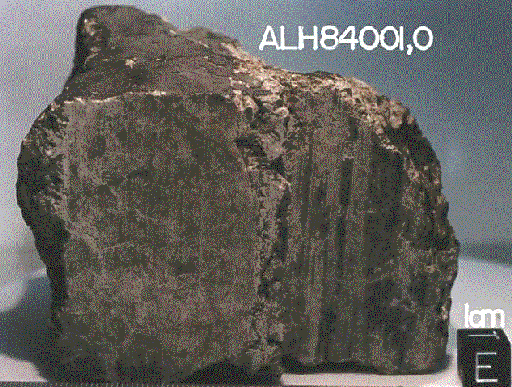Explanation: The famous Martian meteorite pictured above houses microscopic structures interpreted by many as fossils of ancient Martian life. How do you find a meteorite from Mars here on Earth? On a typical day, several large rocks fall to Earth from space, usually winding up in the oceans. If they do not burn up in the Earth's atmosphere they are called meteorites. (Danger from falling meteorites is rare: the average person would have to repair meteorite damage to their home about every 100 million years.) Most meteorites falling on land are never located or identified - appearing similar to other rocks to the untrained eye. In certain places in Antarctica, however, meteorites stand out from the white frozen ice and snow beneath them, as if they were just left yesterday. When the above meteorite was found in Antarctica, it was considered unusual because of its grey color. So far, about 12 Martian meteorites of similar mineral compostion have been found. One of these contains minute pockets of gases identical in isotopic composition to the Martian atmosphere as determined from the Viking measurements - implying the rocks indeed originated on Mars. These Martian meteorites are typically 1.3 billion years old or less, however, the one containing the potential microfossils appears to have an age of about 4.5 billion years.
1999 2000 2001 2002 2003 2004 2005 2006 2007 2008 2009 2010 2011 2012 2013 2014 2015 2016 2017 2018 2019 2020 2021 2022 2023 2024 2025 |
Январь Февраль Март Апрель Май Июнь Июль Август Сентябрь Октябрь Ноябрь Декабрь |
NASA Web Site Statements, Warnings, and Disclaimers
NASA Official: Jay Norris. Specific rights apply.
A service of: LHEA at NASA / GSFC
& Michigan Tech. U.
|
Публикации с ключевыми словами:
метеорит - жизнь на Марсе - Антарктида
Публикации со словами: метеорит - жизнь на Марсе - Антарктида | |
См. также:
Все публикации на ту же тему >> | |
